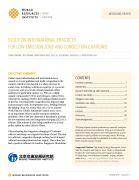Estudio Sobre Prácticas Internacionales para Zonas de Baja Emisión y Carga por Congestión

Sinopsis
La congestión del tráfico y su alto costo socioeconómico, provocado por la rápida urbanización de China, han forzado la demanda de mitigación de congestión y reducción de emisiones en el sector del transporte en la agenda del gobierno. Varias ciudades chinas como Beijing, Shanghai, Hangzhou y Suzhou están considerando mitigar estos problemas crecientes de contaminación del aire y congestión del tráfico a través de las políticas de zona de baja emisión (LEO) y de congestión (CC). Con base en las demandas de política de la Comisión Municipal de Transporte de Beijing (BMCT), el World Resources Institute (WRI), en asociación con el Instituto de Transporte de Beijing (BTI), realizó una investigación completa y exhaustiva sobre la experiencia exitosa de Londres, Singapur y Estocolmo que tienen inició LEZ / CC, con un análisis centrado en la etapa de preparación, el diseño del esquema, la tecnología, la comunicación pública, la implementación y la gestión, y los efectos de las políticas. Este documento de trabajo discute prácticas que se pueden aplicar a China, con el objetivo de resolver problemas y desafíos en el esfuerzo de mitigación de congestión y reducción de emisiones.
Resumen ejecutivo
This paper was developed based on interviews with experts in LEZ/CC policies, and observations made during study tours in London, Stockholm and Singapore. It aims to help readers understand how LEZ/CC policies work to alleviate air pollution and greenhouse gas (GHG) emissions. The paper addresses the following questions:
- What are the main challenges to introducing the LEZ/CC scheme?
- What are the main concerns expressed by stakeholders?
- Are there any complementary measurements to support the LEZ/CC scheme?
- How can public acceptance be improved through public communication?
- What are the main factors to consider when selecting LEZ/CC enforcement technologies?
- What are the benefits generated by the LEZ/CC scheme?
- The analysis of the successful experience of London, Singapore and Stockholm leads to the following recommendations for decision makers in China’s context in order to promote the implementation of LEZ and CC in China:
The analysis of the successful experience of London, Singapore and Stockholm leads to the following recommendations for decision makers in China’s context in order to promote the implementation of LEZ and CC in China:
1. National Government
- The national government should combine the objectives of local LEZ/CC schemes with national transportation strategies in a clear and consistent manner and support the implementation of local policies through favorable legislation, regulation and policies.
- The municipal government should set clear and strong objectives before implementing the LEZ/CC scheme.
- Local government should conduct comprehensive studies focusing on implementation details, such as charging fees and targets.
- The allocation of revenues should be dedicated to transportation system improvements and the process should be transparent.
- Field-proven technologies that are appropriate to local circumstances offer the greatest chance of successful implementation.
- Public communication strategies should be effective, and updated to take account of public feedback and enable public communication to serve its purpose of improving policy acceptability.
- A complete set of complementary measurements that offer viable alternative travel options and mitigate potentially unwelcome impacts of the scheme should be developed before implementation.